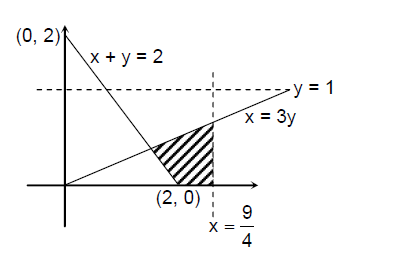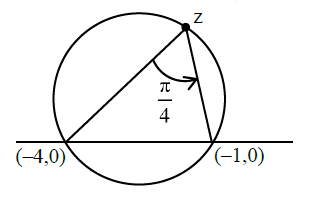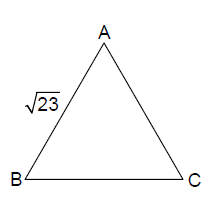Sample Paper
PART-3: MATHEMATICS
SECTION-1 : (Maximum Marks: 12)
- This section contains four (04) questions.
- Each question has FOUR options (A), (B), (C), and (D). Only one of these four options is the correct answer.
- For each question, choose the option corresponding to the correct answer.
- Answer to each question will be evaluated according to the following marking scheme:
Full Marks: “+3” If ONLY the correct option is chosen;
Zero Marks: “0” If none of the options is chosen (i.e. the question is unanswered);
Negative Marks: “−1” In all other cases.
Q1. Consider a triangle \(\Delta\) whose two sides lie on the \(x\)-axis and the line \(x+y+1=0\). If the orthocenter of \(\Delta\) is \((1,1)\), then the equation of the circle passing through the vertices of the triangle \(\Delta\) is
(A) \(x^{2}+y^{2}-3 x+y=0\)
(B) \(x^{2}+y^{2}+x+3 y=0\)
(C) \(x^{2}+y^{2}+2 y-1=0\)
(D) \(x^{2}+y^{2}+x+y=0\)
Answer: B
Solution:
Image of orthocentre about any side of the triangle lies on its circumcircle. We can observe that \(x^{2}+y^{2}+x+3 y=0\) is satisfied by both \((-1,0)\) and \((1,-1)\). So, option “B” is the correct choice.
Q2. The area of the region \(\left\{(x, y): 0 \leq x \leq \frac{9}{4}, \quad 0 \leq y \leq 1, \quad x \geq 3 y, \quad x+y \geq 2\right\}\) is
(A) \(\frac{11}{32}\)
(B) \(\frac{35}{96}\)
(C) \(\frac{37}{96}\)
(D) \(\frac{13}{32}\)
Answer: A
Solution:

Area of the shaded region
\(
\begin{aligned}
&=\frac{1}{2}\left(\frac{2}{3}+\frac{3}{4}\right) \frac{1}{4}+\frac{1}{2} \times \frac{2}{3} \times \frac{1}{2} \\
&=\frac{11}{32}
\end{aligned}
\)
Q3. Consider three sets \(\mathrm{E}_{1}=\{1,2,3\}, \mathrm{F}_{1}=\{1,3,4\}\) and \(\mathrm{G}_{1}=\{2,3,4,5\}\). Two elements are chosen at random, without replacement, from the set \(\mathrm{E}_{1}\), and let \(\mathrm{S}_{1}\) denote the set of these chosen elements. Let \(\mathrm{E}_{2}=\mathrm{E}_{1}-\mathrm{S}_{1}\) and \(\mathrm{F}_{2}=\mathrm{F}_{1} \cup \mathrm{S}_{1}\). Now two elements are chosen at random, without replacement, from the set \(\mathrm{F}_{2}\) and let \(\mathrm{S}_{2}\) denote the set of these chosen elements.
Let \(\mathrm{G}_{2}=\mathrm{G}_{1} \cup \mathrm{S}_{2}\). Finally, two elements are chosen at random, without replacement, from the set \(\mathrm{G}_{2}\) and let \(\mathrm{S}_{3}\) denote the set of these chosen elements.
Let \(\mathrm{E}_{3}=\mathrm{E}_{2} \cup \mathrm{S}_{3}\). Given that \(\mathrm{E}_{1}=\mathrm{E}_{3}\), let \(\mathrm{p}\) be the conditional probability of the event \(\mathrm{S}_{1}=\{1,2\}\). Then the value of \(\mathrm{p}\) is
(A) \(\frac{1}{5}\)
(B) \(\frac{3}{5}\)
(C) \(\frac{1}{2}\)
(D) \(\frac{2}{5}\)
Answer: A
Solution:
\(\begin{array}{llllll} & \mathrm{S}_{1} & \mathrm{~F}_{2}=\mathrm{F}_{1} \cup \mathrm{S}_{1} & \mathrm{~S}_{2} & \mathrm{G}_{1} \cup \mathrm{S}_{2}=\mathrm{G}_{2} & \mathrm{~S}_{3} \\ \text { (i) } & \{1,2\} & \{1,2,3,4) & \{1, \mathrm{x}\} & \{1,2,3,4,5\} & \{1,2\} \\ \text { (ii) } & \{2,3\} & \{1,2,3,4\} & \{1, \mathrm{x}\} & \{1,2,3,4,5\} & \{2,3\} \\ & & & \{\mathrm{x}, \mathrm{y}\} \text { (where x and y } & \text { or }\{2,3,4,5\} & \\ \text { (iii) } & \{1,3\} & \{1,3,4\} & \{1, \mathrm{x}\} \text { are other than 1) } & \{1,2,3,4,5\} & \{1,3\}\end{array}\)
(I) \(\quad \mathrm{P}_{1}=\frac{{ }^{2} c_{2}}{{ }^{3} c_{2}} \cdot \frac{{ }^{3} c_{1}}{{ }^{4} c_{2}} \cdot \frac{{ }^{2} c_{1}}{{ }^{5} c_{2}}=\frac{1}{60}\)
(ii) \(\mathrm{P}_{2}=\frac{1}{3}\left(\frac{{ }^{3} c_{1}}{{ }^{4} c_{2}} \times \frac{{ }^{2} c_{2}}{{ }^{5} c_{2}}+\frac{{ }^{3} c_{2}}{{ }^{4} c_{2}} \times \frac{{ }^{2} c_{2}}{{ }^{4} c_{2}}\right)=\frac{2}{45}\)
(iii) \(\quad \mathrm{P}_{3}=\frac{1}{{ }^{3} \mathrm{c}_{1}} \times \frac{{ }^{2} \mathrm{c}_{1}}{{ }^{3} \mathrm{c}_{2}} \times \frac{{ }^{2} \mathrm{c}_{2}}{{ }^{5} \mathrm{c}_{2}}=\frac{1}{45}\)
Conditional probability \(=\frac{P_{1}}{P_{1}+P_{2}+P_{3}}=\frac{1}{5}\)
Q4. Let \(\theta_{1}, \theta_{2}, \ldots, \theta_{10}\) be positive valued angles (in radian) such that \(\theta_{1}+\theta_{2}+\ldots+\theta_{10}=2 \pi\). Define the complex numbers \(z_{1}=e^{i \theta_{1}}, z_{k}=z_{k-1} e^{i \theta_{k}}\) for \(k=2,3, \ldots, 10\), where \(i=\sqrt{-1}\). Consider the statements P and Q given below :
\(\mathrm{P}:\left|\mathrm{z}_{2}-\mathrm{z}_{1}\right|+\left|\mathrm{z}_{3}-\mathrm{z}_{2}\right|+\ldots+\left|\mathrm{z}_{10}-\mathrm{z}_{9}\right|+\left|\mathrm{z}_{1}-\mathrm{z}_{10}\right| \leq 2 \pi\)
Q : \(\left|z_{2}^{2}-z_{1}^{2}\right|+\left|z_{3}^{2}-z_{2}^{2}\right|+\ldots .+\left|z_{10}^{2}-z_{9}^{2}\right|+\left|z_{1}^{2}-z_{10}^{2}\right| \leq 4 \pi\)
Then,
(A) P is TRUE and Q is FALSE
(B) Q is TRUE and P is FALSE
(C) both P and Q are TRUE
(D) both P and Q are FALSE
Answer: C
Solution:
\(
\begin{aligned}
&\because z_{1}=e^{i \theta_{1}} \\
&\text { So, } z_{2}=e^{i\left(\theta_{1}+\theta_{2}\right)} \\
&z_{3}=e^{i\left(\theta_{1}+\theta_{2}+\theta_{3}\right)} \\
&\vdots \\
&z_{10}=e^{i\left(\theta_{1}+\theta_{2}+\ldots .+\theta_{10}\right)}=e^{i(2 \pi)}
\end{aligned}
\)
Sum of all the chord length \(<\) Circumference
So, \(\sum\left|z_{2}-z_{1}\right| \leq 2 \pi\)
Also, \(2\left|z_{2}-z_{1}\right| \geq\left|z_{2}^{2}-z_{1}^{2}\right|\)
Hence, \(2\left(\left|z_{2}-z_{1}\right|+\ldots .+\left|z_{10}-z_{1}\right|\right) \leq 2(2 \pi)=4 \pi\)
So for, we have \(P \leq 2 \pi\) and \(Q \leq 4 \pi\)
Section-II: (Maximum Marks : 12)
- This section contains three (03) question stems.
- There are two(02) questions corresponding to each question stem.
- The answer to each question is a numerical value.
- For each question, enter the correct numerical value corresponding to the answer in the designated
place using the mouse and the on-screen virtual numeric keypad. - If the numerical value has more than two decimal places, truncate/round-off the value to TWO
decimal places. - Answers to each question will be evaluated according to the following marking scheme:
Full Marks: “+2” If only the correct numerical value is entered at the designated place;
Zero Marks: “0” In all other cases
Question Stem for Question Nos. 5 and 6
Three numbers are chosen at random, one after another with replacement, from the set \(S=\{1,2,3, \ldots, 100\}\). Let \(p_{1}\) be the probability that the maximum of chosen numbers is at least 81 and \(\mathrm{p}_{2}\) be the probability that the minimum of chosen numbers is at most 40.
Q5. The value of \(\frac{625 p_{1}}{4}\) is _________.
Answer: 76.25
Solution:
\(\mathrm{p}_{1}=\) probability that maximum of chosen numbers is at least 81
\(\mathrm{p}_{1}=1\) – probability that maximum of chosen number is at most 80
\(\mathrm{p}_{1}=1-\frac{80 \times 80 \times 80}{100 \times 100 \times 100}=1-\frac{64}{125}\)
\(\mathrm{p}_{1}=\frac{61}{125}\)
\(\frac{625 \mathrm{p}_{1}}{4}=\frac{625}{4} \times \frac{61}{125}=\frac{305}{4}=76.25\)
Q6. The value of \(\frac{125}{4} \mathrm{p}_{2}\) is _______.
Answer: 24.50
Solution:
\(\mathrm{p}_{2}=\) probability that minimum of chosen numbers is at most 40
\(=1-\) probability that minimum of chosen numbers is at least 41
\(
\begin{aligned}
&=1-\left(\frac{600}{100}\right)^{3} \\
&=1-\frac{27}{125}=\frac{98}{125} \\
&\therefore \frac{125}{4} \mathrm{p}_{2}=\frac{125}{4} \times \frac{98}{125}=24.50
\end{aligned}
\)
Question Stem for Question Nos. 7 and 8
Let \(\alpha, \beta\) and \(\gamma\) be real numbers such that the system of linear equations
\(
\begin{gathered}
x+2 y+3 z=\alpha \\
4 x+5 y+6 z=\beta \\
7 x+8 y+9 z=\gamma-1
\end{gathered}
\)
is consistent. Let [/latex]|\mathrm{M}|[/latex] represent the determinant of the matrix
\(
\mathbf{M}=\left[\begin{array}{ccc}
\alpha & 2 & \gamma \\
\beta & 1 & 0 \\
-1 & 0 & 1
\end{array}\right]
\)
Let \(P\) be the plane containing all those \((\alpha, \beta, \gamma)\) for which the above system of linear equations is consistent, and \(\mathrm{D}\) be the square of the distance of the point \((0,1,0)\) from the plane \(\mathrm{P}\)
Q7. The value of \(|\mathrm{M}|\) is ______.
Answer: 1
Q8. The value of D is _________.
Answer: 1.5
Solution:
\(
\begin{aligned}
&7 x+8 y+9 z-(\gamma-1)=A(4 x+5 y+6 z-\beta)+B(x+2 y+3 z-\alpha) \\
&x: 7=4 A+B \\
&y: 8=5 \mathrm{A}+2 \mathrm{~B} \\
&A=2, B=-1 \\
&\text { const. term }:-(\gamma-1)=-A \beta-\alpha B \Rightarrow-(\gamma-1) \equiv 2 \beta+\alpha \\
&\alpha-2 \beta+\gamma=1 \\
&M=\left(\begin{array}{lll}
\alpha & 2 & \gamma \\
\beta & 1 & 0 \\
-1 & 0 & 1
\end{array}\right)=\alpha-2 \beta+\gamma=1
\end{aligned}
\)
Plane \(\mathrm{P}: \mathrm{x}-2 \mathrm{y}+\mathrm{z}=1\)
Perpendicular distance \(=\left|\frac{3}{\sqrt{6}}\right|=\mathrm{P} \Rightarrow \mathrm{D}=\mathrm{P}^{2}=\frac{9}{6}=1.5\)
Question Stem for Question Nos. 9 and 10
Consider the lines \(\mathrm{L}_{1}\) and \(\mathrm{L}_{2}\) defined by \(\mathrm{L}_{1}: \mathrm{x} \sqrt{2}+\mathrm{y}-1=0\) and \(\mathrm{L}_{2}: \mathrm{x} \sqrt{2}-\mathrm{y}+1=0\)
For a fixed constant \(\lambda\), let \(\mathrm{C}\) be the locus of a point \(\mathrm{P}\) such that the product of the distance of \(\mathrm{P}\) from \(\mathrm{L}_{1}\) and the distance of \(\mathrm{P}\) from \(\mathrm{L}_{2}\) is \(\lambda^{2}\). The line \(\mathrm{y}=2 \mathrm{x}+1\) meets \(\mathrm{C}\) at two points \(\mathrm{R}\) and \(\mathrm{S}\), where the distance between \(\mathrm{R}\) and \(\mathrm{S}\) is \(\sqrt{270}\).
Let the perpendicular bisector of RS meet \(\mathrm{C}\) at two distinct points \(\mathrm{R}^{\prime}\) and \(\mathrm{S}^{\prime}\). Let \(\mathrm{D}\) be the square of the distance between \(R^{\prime}\) and \(S^{\prime}\).
Q9. The value of \(\lambda^{2}\) is ________.
Answer: 9
Solution:
\(\begin{aligned}&\mathrm{P}(\mathrm{x}, \mathrm{y}) \quad\left|\frac{\sqrt{2} \mathrm{x}+\mathrm{y}-1}{\sqrt{3}}\right|\left|\frac{\sqrt{2} \mathrm{x}-\mathrm{y}+1}{\sqrt{3}}\right|=\lambda^{2} \\
&\left|\frac{2 \mathrm{x}^{2}-(\mathrm{y}-1)^{2}}{3}\right|=\lambda^{2}, \mathrm{C}:\left|2 \mathrm{x}^{2}-(\mathrm{y}-1)^{2}\right|=3 \lambda^{2} \\
&\text { line } \mathrm{y}=2 \mathrm{x}+1, \mathrm{RS}=\sqrt{\left(\mathrm{x}_{1}-\mathrm{x}_{2}\right)^{2}+\left(\mathrm{y}_{1}-\mathrm{y}_{2}\right)^{2}}, \mathrm{R}\left(\mathrm{x}_{1}, \mathrm{y}_{1}\right) \text { and } \mathrm{S}\left(\mathrm{x}_{2}, \mathrm{y}_{2}\right) \\
&\mathrm{y}_{1}=2 \mathrm{x}_{1}+1 \text { and } \mathrm{y}_{2}=2 \mathrm{x}_{2}+1 \Rightarrow\left(\mathrm{y}_{1}-\mathrm{y}_{2}\right)=2\left(\mathrm{x}_{1}-\mathrm{x}_{2}\right) \\
&\mathrm{RS}=\sqrt{5\left(\mathrm{x}_{1}-\mathrm{x}_{2}\right)^{2}}=\sqrt{5}\left|\mathrm{x}_{1}-\mathrm{x}_{2}\right| \\
&\text { solve curve } \mathrm{C} \text { and line } \mathrm{y}=2 \mathrm{x}+1 \text { we get } \\
&\left|2 \mathrm{x}^{2}-(2 \mathrm{x})^{2}\right|=3 \lambda^{2} \Rightarrow \mathrm{x}^{2}=\frac{3 \lambda^{2}}{2} \\
&\mathrm{RS}=\sqrt{5}\left|\frac{2 \sqrt{3} \lambda}{\sqrt{2}}\right|=\sqrt{30} \lambda=\sqrt{270} \Rightarrow 30 \lambda^{2}=270 \Rightarrow \lambda^{2}=9
\end{aligned}\)
Q10. The value of D is __________.
Answer: 77.14
Solution:

Perpendicular bisector of RS
\(
\mathrm{T} \equiv\left(\frac{\mathrm{x}_{1}+\mathrm{x}_{2}}{2}, \frac{\mathrm{y}_{1}+\mathrm{y}_{2}}{2}\right)
\)
Here \(x_{1}+x_{2}=0\)
\(
\mathrm{T}=(0,1)
\)
Equation of
\(
\mathrm{R}^{\prime} \mathrm{S}^{\prime}:(\mathrm{y}-1)=-\frac{1}{2}(\mathrm{x}-0) \Rightarrow \mathrm{x}+2 \mathrm{y}=2
\)
\(\mathrm{R}^{\prime}\left(\mathrm{a}_{1}, \mathrm{~b}_{1}\right) \mathrm{S}^{\prime}\left(\mathrm{a}_{2}, \mathrm{~b}_{2}\right)\)
\(
\mathrm{D}=\left(\mathrm{a}_{1}-\mathrm{a}_{2}\right)^{2}+\left(\mathrm{b}_{1}-\mathrm{b}_{2}\right)^{2}=5\left(\mathrm{~b}_{1}-\mathrm{b}_{2}\right)^{2}
\)
solve \(x+2 y=2\) and \(\left|2 x^{2}-(y-1)^{2}\right|=3 \lambda^{2}\)
\(
\left|8(y-1)^{2}-(y-1)^{2}\right|=3 \lambda^{2} \Rightarrow(y-1)^{2}=\left(\frac{\sqrt{3} \lambda}{\sqrt{7}}\right)^{2}
\)
\(
\mathrm{y}-1=\pm \frac{\sqrt{3} \lambda}{\sqrt{7}} \Rightarrow \mathrm{b}_{1}=1+\frac{\sqrt{3} \lambda}{\sqrt{7}}, \mathrm{~b}_{2}=1-\frac{\sqrt{3} \lambda}{\sqrt{17}}
\)
\(
\mathrm{D}=5\left(\frac{2 \sqrt{3} \lambda}{\sqrt{7}}\right)^{2}=\frac{5 \times 4 \times 3 \lambda^{2}}{7}=\frac{5 \times 4 \times 27}{7}=77.14
\)
SECTION-3 : (Maximum Marks : 24)
- This section contains six (06) questions.
- Each question has four options (A), (B), (C), and (D). One or more than one of these
four option(s) is (are) correct answer(s). - For each question, choose the option(s) corresponding to (all) the correct answer(s).
- Answer to each question will be evaluated according to the following marking scheme:
Full Marks : “+4” If only (all) the correct option(s) is(are) chosen;
Partial Marks: “+3” If all the four options are correct but ONLY three options are chosen;
Partial Marks: “+2” If three or more options are correct but ONLY two options are chosen,
both of which are correct;
Partial Marks: “+1” If two or more options are correct but ONLY one option is chosen and it
is a correct option;
Zero Marks: “0” If unanswered;
Negative Marks: “−2” In all other cases
Q11. For any \(3 \times 3\) matrix \(\mathrm{M}\), let \(|\mathrm{M}|\) denote the determinant of \(\mathrm{M}\). Let
\(
\mathrm{E}=\left[\begin{array}{ccc}
1 & 2 & 3 \\
2 & 3 & 4 \\
8 & 13 & 18
\end{array}\right], P=\left[\begin{array}{lll}
1 & 0 & 0 \\
0 & 0 & 1 \\
0 & 1 & 0
\end{array}\right] \text { and } F=\left[\begin{array}{ccc}
1 & 3 & 2 \\
8 & 18 & 13 \\
2 & 4 & 3
\end{array}\right]
\)
If \(\mathrm{Q}\) is a nonsingular matrix of order \(3 \times 3\), then which of the following statements is (are) TRUE ?
(A) \(\mathrm{F}=\mathrm{PEP}\) and \(\mathrm{P}^{2}=\left[\begin{array}{lll}1 & 0 & 0 \\ 0 & 1 & 0 \\ 0 & 0 & 1\end{array}\right]\)
(B) \(\left|\mathrm{EQ}+\mathrm{PFQ}^{-1}\right|=|\mathrm{EQ}|+\left|\mathrm{PFQ}^{-1}\right|\)
(C) \(\left|(\mathrm{EF})^{3}\right|>|\mathrm{EF}|^{2}\)
(D) Sum of the diagonal entries of \(\mathrm{P}^{-1} \mathrm{EP}+\mathrm{F}\) is equal to the sum of diagonal entries of \(\mathrm{E}+\mathrm{P}^{-1} \mathrm{FP}\)
Answer: A,B & D
Solution:
\(\begin{aligned}&\text { (A) }\mathrm{PEP}=\left(\begin{array}{lll}
1 & 0 & 0 \\
0 & 0 & 1 \\
0 & 1 & 0
\end{array}\right)\left(\begin{array}{ccc}
1 & 2 & 3 \\
2 & 3 & 4 \\
8 & 13 & 18
\end{array}\right)\left(\begin{array}{ccc}
1 & 0 & 0 \\
0 & 0 & 1 \\
0 & 1 & 0
\end{array}\right)\\
&\left(\begin{array}{ccc}
1 & 2 & 3 \\
8 & 13 & 18 \\
2 & 3 & 4
\end{array}\right)\left(\begin{array}{lll}
1 & 0 & 0 \\
0 & 0 & 1 \\
0 & 1 & 0
\end{array}\right)=\left(\begin{array}{ccc}
1 & 3 & 2 \\
8 & 18 & 13 \\
2 & 4 & 3
\end{array}\right)\\
&\mathrm{P}^{2}=\left(\begin{array}{lll}
1 & 0 & 0 \\
0 & 0 & 1 \\
0 & 1 & 0
\end{array}\right)\left(\begin{array}{lll}
1 & 0 & 0 \\
0 & 0 & 1 \\
0 & 1 & 0
\end{array}\right)=\left(\begin{array}{lll}
1 & 0 & 0 \\
0 & 1 & 0 \\
0 & 0 & 1
\end{array}\right)\\
&\text { (B) }\left|\mathrm{EQ}+\mathrm{PFQ}^{-1}\right|=|\mathrm{EQ}|+\left|\mathrm{PFQ}^{-1}\right|\\
&|\mathrm{E}|=0 \text { and }|\mathrm{F}|=0 \text { and }|\mathrm{Q}| \neq 0\\
&|\mathrm{EQ}|=|\mathrm{E}||\mathrm{Q}|=0,\left|\mathrm{PFQ}^{-1}\right|=\frac{|\mathrm{P}||\mathrm{F}|}{|\mathrm{Q}|}=0\\
&\mathrm{T}=\mathrm{EQ}+\mathrm{PFQ}^{-1}\\
&\mathrm{TQ}=\mathrm{EQ}^{2}+\mathrm{PF}=\mathrm{EQ}^{2}+\mathrm{P}^{2} \mathrm{EP}=\mathrm{EQ}^{2}+\mathrm{EP}=\mathrm{E}\left(\mathrm{Q}^{2}+\mathrm{P}\right)\\
&\left.|\mathrm{TQ}|=\left|\mathrm{E}\left(\mathrm{Q}^{2}+\mathrm{P}\right)\right| \Rightarrow|\mathrm{T}||\mathrm{Q}|=|\mathrm{E}|\left|\mathrm{Q}^{2}+\mathrm{P}\right|=0 \Rightarrow|\mathrm{T}|=0 \quad \text { (as }|\mathrm{Q}| \neq 0\right)\\
&\text { (C) }\left|(\mathrm{EF})^{3}\right|>|\mathrm{EF}|^{2}\\
&\text { Here } 0>0 \text { (false) }\\
&\text { (D) as } \mathrm{P}^{2}=\mathrm{I} \Rightarrow \mathrm{P}^{-1}=\mathrm{P} \text { so } \mathrm{P}^{-1} \mathrm{FP}=\mathrm{PFP}=\mathrm{PPEPP}=\mathrm{E}\\
&\text { so } \mathrm{E}+\mathrm{P}^{-1} \mathrm{FP}=\mathrm{E}+\mathrm{E}=2 \mathrm{E}\\
&\mathrm{P}^{-1} \mathrm{EP}+\mathrm{F} \Rightarrow \mathrm{PEP}+\mathrm{F}=2 \mathrm{PEP}
\end{aligned}\)
Therefore, (C) is False.
Q12. Let \(f: \mathbb{R} \rightarrow \mathbb{R}\) be defined by
\(
f(x)=\frac{x^{2}-3 x-6}{x^{2}+2 x+4}
\)
Then which of the following statements is (are) TRUE?
(A) \(f\) is decreasing in the interval \((-2,-1)\)
(B) \(f\) is increasing in the interval \((1,2)\)
(C) \(f\) is onto
(D) Range of \(f\) is \(\left[-\frac{3}{2}, 2\right]\)
Answer: A & B
Solution:
\(\begin{aligned}&f^{\prime}(x)=\frac{5 x(x+4)}{\left(x^{2}+2 x+4\right)^{2}} \\
&f(0)=-\frac{3}{2} \text { (point of local minima) } \\
&f(-4)=\frac{11}{6} \text { (point of local maxima) }
\end{aligned}\)
Q13. Let \(\mathrm{E}, \mathrm{F}\) and \(\mathrm{G}\) be three events having probabilities \(\mathrm{P}(\mathrm{E})=\frac{1}{8}, \mathrm{P}(\mathrm{F})=\frac{1}{6}\) and \(\mathrm{P}(\mathrm{G})=\frac{1}{4}\), and let \(\mathrm{P}(\mathrm{E} \cap \mathrm{F} \cap \mathrm{G})=\frac{1}{10}\)
For any event \(\mathrm{H}\), if \(\mathrm{H}^{\mathrm{C}}\) denotes its complement, then which of the following statements is(are) TRUE ?
(A) \(\mathrm{P}\left(\mathrm{E} \cap \mathrm{F} \cap \mathrm{G}^{\mathrm{C}}\right) \leq \frac{1}{40}\)
(B) \(\mathrm{P}\left(\mathrm{E}^{\mathrm{C}} \cap \mathrm{F} \cap \mathrm{G}\right) \leq \frac{1}{15}\)
(C) \(\mathrm{P}(\mathrm{E} \cup \mathrm{F} \cup \mathrm{G}) \leq \frac{13}{24}\)
(D) \(\mathrm{P}\left(\mathrm{E}^{\mathrm{C}} \cap \mathrm{F}^{\mathrm{C}} \cap \mathrm{G}^{\mathrm{C}}\right) \leq \frac{5}{12}\)
Answer: A, B & C
Q14. For any \(3 \times 3\) matrix \(M\), let \(|\mathrm{M}|\) denote the determinant of \(\mathrm{M}\). Let \(\mathrm{I}\) be the \(3 \times 3\) identity matrix. Let \(E\) and \(F\) be two \(3 \times 3\) matrices such that (I – EF) is invertible. If \(G=(I-E F)^{-1}\), then which of the following statements is (are) TRUE?
(A) \(|\mathrm{FE}|=|\mathrm{I}-\mathrm{EF}||\mathrm{FGE}|\)
(B) \(|\mathrm{I}-\mathrm{FE}|(\mathrm{I}+\mathrm{FGE})=\mathrm{I}\)
(C) \(\mathrm{EFG}=\mathrm{GEF}\)
(D) \((\mathrm{I}-\mathrm{FE})(\mathrm{I}-\mathrm{FGE})=\mathrm{I}\)
Answer: A, B, and C
Solution:
\(
\mathrm{G}(\mathrm{I}-\mathrm{EF})=(\mathrm{I}-\mathrm{EF}) \mathrm{G}=\mathrm{I}
\)
\(
\Rightarrow \mathrm{G}-\mathrm{GEF}=\mathrm{G}-\mathrm{EFG}=\mathrm{I}
\)
(A) \(|\mathrm{FE}|=|\mathrm{I}-\mathrm{FE}||\mathrm{FGE}|=|\mathrm{FGE}-\mathrm{FE} \mathrm{FGE}|
=|\mathrm{FGE}-\mathrm{F}(\mathrm{G}-\mathrm{I}) \mathrm{E}|=|\mathrm{FGE}-\mathrm{FGE}+\mathrm{FE}|=|\mathrm{FE}|
\)
(B) \((\mathrm{I}-\mathrm{FE})(\mathrm{I}+\mathrm{FGE})=\mathrm{I}+\mathrm{FGE}-\mathrm{FE}-\mathrm{FEFGH}
=\mathrm{I}+\mathrm{FGE}-\mathrm{FE}-\mathrm{F}(\mathrm{G}-\mathrm{I}) \mathrm{E}=\mathrm{I}+\mathrm{FGE}-\mathrm{FE}-\mathrm{FGE}+\mathrm{FE}=\mathrm{I}\)
(C)
\(\begin{aligned}&|\mathrm{I}-\mathrm{EF}| \neq 0 ; \mathrm{G}=(\mathrm{I}-\mathrm{EF})^{-1} \Rightarrow \mathrm{G}^{-1}=\mathrm{I}-\mathrm{EF} \\
&\Rightarrow \mathrm{G}(\mathrm{I}-\mathrm{EF})=\mathrm{I}=\mathrm{G}^{-1} \mathrm{G}=(\mathrm{I}-\mathrm{EF}) \mathrm{G} \\
&\Rightarrow \mathrm{G}-\mathrm{GEF}=\mathrm{I}=\mathrm{G}-\mathrm{EFG} \\
&\Rightarrow \mathrm{GEF}=\mathrm{EFG} \quad \\
\end{aligned}
\)
(D)
\(\begin{aligned}
&(\mathrm{I}-\mathrm{FE})(\mathrm{I}-\mathrm{FGE})=\mathrm{I}-\mathrm{FGE}-\mathrm{FE}+\mathrm{FEFGE} \\
=& \mathrm{I}-\mathrm{FGE}-\mathrm{FE}+\mathrm{F}(\mathrm{G}-\mathrm{I}) \mathrm{E}=\mathrm{I}-\mathrm{FGE}-\mathrm{FE}+\mathrm{FGE}-\mathrm{FE} =\mathrm{I}-2 \mathrm{FE}
\end{aligned}\)
Only D is FALSE.
Q15. For any positive integer \(n\), let \(S_{n}:(0, \infty) \rightarrow \mathbb{R}\) be defined by
\( S_{n}(x)=\sum_{k=1}^{n} \cot ^{-1}\left(\frac{1+k(k+1) x^{2}}{x}\right),\)
where for any \(x \in \mathbb{R} \cot ^{-1} x \in(0, \pi)\) and \(\tan ^{-1}(x) \in\left(-\frac{\pi}{2}, \frac{\pi}{2}\right)\). Then which of the following statements is (are) TRUE?
(A) \(S_{10}(x)=\frac{\pi}{2}-\tan ^{-1}\left(\frac{1+11 x^{2}}{10 x}\right)\), for all \(x>0\)
(B) \(\lim _{n \rightarrow \infty} \cot \left(S_{n}(x)\right)=x\), for all \(x>0\)
(C) The equation \(S_{3}(x)=\frac{\pi}{4}\) has a root in \((0, \infty)\)
(D) \(\tan \left(S_{n}(x)\right) \leq \frac{1}{2}\), for all \(n \geq 1\) and \(x>0\)
Answer: A & B
Solution:
(A)
\(\begin{aligned}
&S_{n}=\sum_{k=1}^{n} \cot ^{-1}\left\{\frac{1+k(k+1) x^{2}}{x}\right\} ; \sum_{k=1}^{n} \cot ^{-1}\left\{\frac{k(k+1) x^{2}+1}{(k+1) x-k x}\right\} \\
&S_{n}=\sum_{k=1}^{n} \cot ^{-1}(k x)-\cot ^{-1}(k+1) x \\
&t_{1}=\cot ^{-1}(x)-\cot ^{-1}(2 x) \\
&t_{2}=\cot ^{-1}(2 x)-\cot ^{-1}(3 x) \\
&t_{3}=\cot ^{-1}(3 x)-\cot ^{-1}(4 x) \\
&\vdots \\
&t_{n}=\cot ^{-1}(n x)-\cot ^{-1}((n+1) x) \\
&S_{n}=\cot ^{-1}(x)-\cot ^{-1}((n+1) x) \\
&\Rightarrow S_{n}=\cot ^{-1}\left(\frac{(n+1) x^{2}+1}{n x}\right) \\
&S_{10}=\cot ^{-1}\left(\frac{11 x^{2}+1}{10 x}\right)=\frac{\pi}{2}-\tan ^{-1}\left(\frac{11 x^{2}+1}{10 x}\right)
\end{aligned}
\)
(B) \(\lim _{n \rightarrow \infty} \cot \left(S_{n}(x)\right)=\lim _{n \rightarrow \infty} \cot \left(\cot ^{-1}\left(\frac{(n+1) x^{2}+1}{n x}\right)\right)=\lim _{n \rightarrow \infty} \frac{n x^{2}+x^{2}+1}{n x}=x\)
(C) \(S_{3}(x)=\cot ^{-1}\left(\frac{4 x^{2}+1}{3 x}\right)=\frac{\pi}{4} \Rightarrow \frac{1+4 x^{2}}{3 x}=1\) \(\Rightarrow 4 \mathrm{x}^{2}-3 \mathrm{x}+1=0\) have imaginary roots, C is false.
(D) \(\tan \left(S_{n}(x)\right)=\tan \left(\cot ^{-1}\left(\frac{1+(n+1) x^{2}}{n x}\right)\right)=\frac{n x}{1+(n+1) x^{2}}=\frac{1}{\frac{1}{n x}+\frac{(n+1) x}{n}}\), D is also False.
Q16. For any complex number \(\mathrm{w}=\mathrm{c}+\) id, let \(\arg (\mathrm{w}) \in(-\pi, \pi]\), where \(\mathrm{i}=\sqrt{-1}\). Let \(\alpha\) and \(\beta\) be real numbers such that for all complex numbers \(z=x+\) iy satisfying \(\arg \left(\frac{z+\alpha}{z+\beta}\right)=\frac{\pi}{4}\), the ordered pair \((\mathrm{x}, \mathrm{y})\) lies on the circle
\(x^{2}+y^{2}+5 x-3 y+4=0\)
Then which of the following statements is (are) TRUE?
(A) \(\alpha=-1\)
(B) \(\alpha \beta=4\)
(C) \(\alpha \beta=-4\)
(D) \(\beta=4\)
Answer: B & D
Solution:

\(\arg \left(\frac{z+\alpha}{z+\beta}\right)=\frac{\pi}{4}\) implies \(z\) is on arc and \((-\alpha, 0) \&(-\beta, 0)\) subtend \(\frac{\pi}{4}\) on \(z\).
And \(z\) lies on \(x^{2}+y^{2}+5 x-3 y+4=0\); So put \(y=0\);
\(
x^{2}+5 x+4=0 \Rightarrow x=-1 ; x=-4
\); Now, \(\arg \left(\frac{\mathrm{z}+\alpha}{\mathrm{z}+\beta}\right)=\frac{\pi}{4} \Rightarrow \mathrm{z}+\alpha=(\mathrm{z}+\beta) \cdot \mathrm{r} \cdot \mathrm{e}^{i \frac{\pi}{4}}\); So, \(\mathrm{z}+\beta=\mathrm{z}+4 \Rightarrow \beta=4 \& \mathrm{z}+\alpha=\mathrm{z}+1 \Rightarrow \alpha=1\)
SECTION-4 : (Maximum Marks: 12)
- This section contains three (03) questions.
- The answer to each question is a non-negative integer.
- For each question, enter the correct integer corresponding to the answer using the mouse and the on-screen virtual numeric keypad in the place designed to enter the answer.
- Answers to each question will be evaluated according to the following marking scheme:
Full Mark: “+4” If ONLY the correct integer is entered;
Zero Marks: “0” In all other cases.
Q17.\(\text { For } x \in \mathbb{R} \text {, then number of real roots of the equation } 3x^{2}-4\left|x^{2}-1\right|+x-1=0 \text { is }\)_______.
Answer: 4
Solution:
\(
\begin{aligned}
&3 \mathrm{x}^{2}-4\left|\mathrm{x}^{2}-1\right|+\mathrm{x}-1=0 \\
&\text { Case-I: }|\mathrm{x}| \geq 1 \\
&3 \mathrm{x}^{2}-4 \mathrm{x}^{2}+4+\mathrm{x}-1=0 \\
&-\mathrm{x}^{2}+\mathrm{x}+3=0 \\
&\mathrm{x}^{2}-\mathrm{x}-3=0 \\
&\mathrm{x}=\frac{1 \pm \sqrt{1+12}}{2}=\frac{1 \pm \sqrt{13}}{2}=\frac{1+\sqrt{13}}{2}, \frac{1-\sqrt{13}}{2} \\
&|\mathrm{x}|<1 \\
&3 \mathrm{x}^{2}+4 \mathrm{x}^{2}-4+\mathrm{x}-1=0 \\
&7 \mathrm{x}^{2}+\mathrm{x}-5=0 \\
&\mathrm{x}=\frac{-1 \pm \sqrt{1+20 \times 7}}{14}=\frac{-1 \pm \sqrt{141}}{14}
\end{aligned}
\)
So, number of real roots =4
Q18. In a triangle \(\mathrm{ABC}\), let \(\mathrm{AB}=\sqrt{23}, \mathrm{BC}=3\) and \(\mathrm{CA}=4\). Then the value of \(\frac{\cot \mathrm{A}+\cot \mathrm{C}}{\cot \mathrm{B}}\) is _________.
Answer: 2
Solution:

&A B=\sqrt{23}=C\\
&\mathrm{BC}=3=\mathrm{a}\\
&\mathrm{CA}=4=\mathrm{b}\\
&\frac{\cot A+\cot C}{\cot B} ; \frac{\frac{\cos A}{\sin A}+\frac{\cos C}{\sin C}}{\frac{\cos B}{\sin B}}\\
&=\frac{\cos A \sin C+\cos C \sin A}{\sin A \cdot \sin C \cdot \frac{\cos B}{\sin B}}=\frac{\sin (A+C) \cdot \sin B}{\sin A \cdot \sin C \cdot \cos B}=\frac{\sin B \cdot \sin B}{\sin A \cdot \sin C \cdot \cos B}\\
&=\frac{b^{2}}{a c \cdot \frac{\left(a^{2}+c^{2}-b^{2}\right)}{2 a c}}=\frac{2 b^{2}}{a^{2}+c^{2}-b^{2}}=\frac{2 \times 16}{9+23-16}=\frac{2 \times 16}{32-16}=\frac{2 \times 16}{16}=2
\end{aligned}\)
Q19. Let \(\overrightarrow{\mathrm{u}}, \overrightarrow{\mathrm{v}}\) and \(\overrightarrow{\mathrm{w}}\) be vectors in three-dimensional space, where \(\overrightarrow{\mathrm{u}}\) and \(\overrightarrow{\mathrm{v}}\) are unit vectors which are not perpendicular to each other and \(\vec{u} \cdot \vec{w}=1, \vec{v} \cdot \vec{w}=1, \vec{w} \cdot \vec{w}=4\)
If the volume of the parallelopiped, whose adjacent sides are represented by the vectors \(\overrightarrow{\mathrm{u}}, \overrightarrow{\mathrm{v}}\) and \(\overrightarrow{\mathrm{w}}\) , is \(\sqrt{2}\), then the value of \(|3 \vec{u}+5 \vec{v}|\) is ______.
Answer: 7
Solution:
Given, \(|\overrightarrow{\mathrm{u}}|=1 ;|\overrightarrow{\mathrm{v}}|=1 ; \overrightarrow{\mathrm{u}} \cdot \overrightarrow{\mathrm{v}} \neq 0 ; \overrightarrow{\mathrm{u}} \cdot \overrightarrow{\mathrm{w}}=1 ; \overrightarrow{\mathrm{v}} \cdot \overrightarrow{\mathrm{w}}=1\);
\(\overrightarrow{\mathrm{w}} \cdot \overrightarrow{\mathrm{w}}=|\overrightarrow{\mathrm{w}}|^{2}=4 \Rightarrow|\overrightarrow{\mathrm{w}}|=2 ;\left[\begin{array}{lll}\overrightarrow{\mathrm{u}} & \overrightarrow{\mathrm{v}} & \overrightarrow{\mathrm{w}}\end{array}\right]=\sqrt{2}\) and \(\left[\begin{array}{lll}\overrightarrow{\mathrm{u}} & \overrightarrow{\mathrm{v}} & \overrightarrow{\mathrm{w}}\end{array}\right]^{2}=\left|\begin{array}{lll}\vec{u} \cdot \overrightarrow{\mathrm{u}} & \overrightarrow{\mathrm{u}} \cdot \overrightarrow{\mathrm{v}} & \overrightarrow{\mathrm{u}} \cdot \overrightarrow{\mathrm{w}} \\ \overrightarrow{\mathrm{v}} \cdot \overrightarrow{\mathrm{u}} & \overrightarrow{\mathrm{v}} \cdot \overrightarrow{\mathrm{v}} & \overrightarrow{\mathrm{v}} \cdot \overrightarrow{\mathrm{w}} \\ \overrightarrow{\mathrm{w}} \cdot \overrightarrow{\mathrm{u}} & \overrightarrow{\mathrm{w}} \cdot \overrightarrow{\mathrm{v}} & \overrightarrow{\mathrm{w}} \cdot \overrightarrow{\mathrm{w}}\end{array}\right|=2\)
\(
\begin{aligned}
&\Rightarrow\left|\begin{array}{ccc}
1 & \overrightarrow{\mathrm{u}} . \overrightarrow{\mathrm{v}} & 1 \\
\overrightarrow{\mathrm{u}} . \overrightarrow{\mathrm{v}} & 1 & 1 \\
1 & 1 & 4
\end{array}\right|=2 \\
&\Rightarrow \overrightarrow{\mathrm{u}} \cdot \overrightarrow{\mathrm{v}}=\frac{1}{2}
\end{aligned}
\)
So, \(|3 \overrightarrow{\mathrm{u}}+5 \overrightarrow{\mathrm{v}}|=\sqrt{9|\overrightarrow{\mathrm{u}}|^{2}+25|\overrightarrow{\mathrm{v}}|^{2}+2 \cdot 3 \cdot 5 \overrightarrow{\mathrm{u}} \cdot \overrightarrow{\mathrm{v}}}\) \(=\sqrt{9+25+30\left(\frac{1}{2}\right)}=\sqrt{49}=7\)